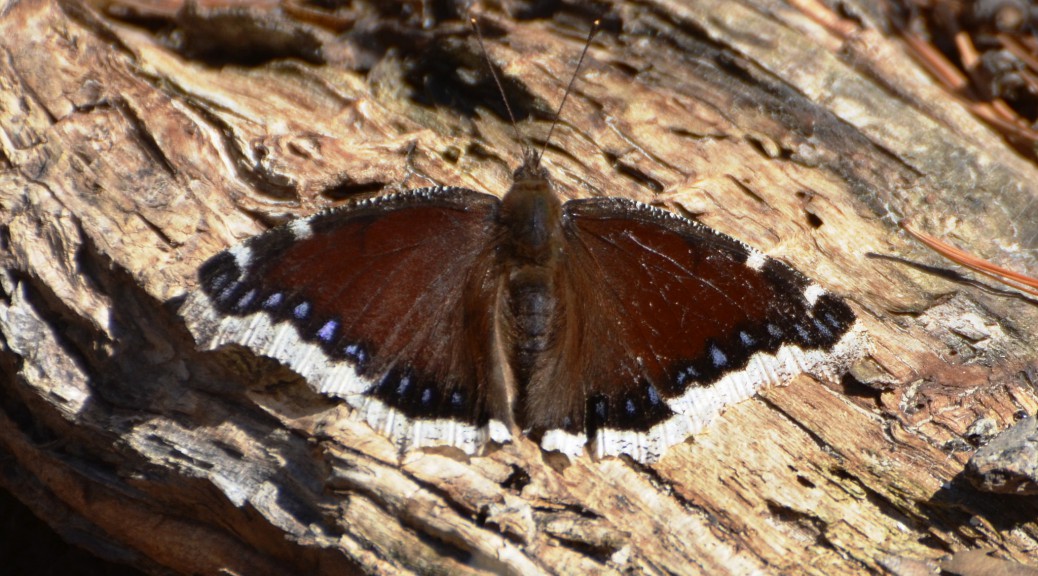
It is a sunny day in March, the temperature hitting close to sixty degrees and I am out hunting for Mourning Cloak butterflies. The drifts of snow still covering the north slopes and hollows do not discourage me because I know their habits: they emerge early in spring–earlier than any other butterfly–seeking sweetness in damaged trees leaking sap as well as mates to continue their life cycle. Up ahead among the hardwood trunks of beech and maple I see a dark flutter—Mourning Cloaks, two of them flying in a tight spiral, a mating dance. I raise my hands to the sky for a moment as an expression of joy at my discovery. As I do, another Mourning Cloak I had missed in my concentration upon the first pair draws close and boldly lands upon the sleeve of my jacket. It flexes his wings once or twice and I beam with joy: What an intelligent and friendly animal this is! We bask in each other’s company.
Mourning Cloaks overwinter as adults, crawling into warm spaces underneath bark or stones, close to soil that remains unfrozen all year long. Among the earliest wildflowers, the Spring Beauties and the Hepatica, they dance in the sunlight, ready to mate, lay eggs, and die, thereby completing their life cycle within a calendar year. The eggs, laid upon host plants poplar and willow, hatch into dark spiky caterpillars, creatures one would hardly guess would change into a splendid adult butterfly.
The adult is mostly a uniform purple-black, a muted yellow border on its wings with a row of blue dots inside of that. Having lived a year already, its wings might appear battered and faded, not furnished with the glowing colors it showed upon its emergence from its pupal case.
This butterfly, like many others, is territorial, males often proclaiming their rights by lighting on the highest object around, understory trees, for example, or hands outstretched in joy at having found Mourning Cloaks in the first days of spring. Or, then again, with that behavior they might be proving they are especially intelligent and friendly insects!
I have found Mourning Cloaks in Northern Michigan hardwoods–consisting of beech, sugar maple, white ash, black cherry–in the months of March, April, and May. They disappear for much of the summer as eggs hatch into caterpillars, caterpillars transform into butterflies, and butterflies “sleep” during the hottest summer months, aestivation the term given to this period of dormancy. In late summer and early fall they appear again, the new adults, seeking nectar and food to get them through our long, cold winters.

The Mourning Cloak is the animal equivalent of Spring Beauty, Trailing Arbutus, and Hepatica, the first wildflowers to appear in spring. We welcome it as we do those flowers, the earliest sign that warmth is returning to the world. Whether you visit the woods for morels or for wildflowers, keep an eye out for these butterflies. And if you hold your hands up, you just might get one to land on you.
Richard Fidler is co-editor of Grand Traverse Journal.


Nice article!